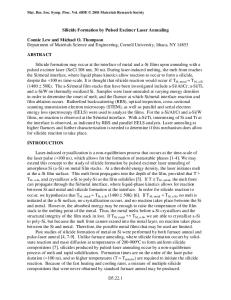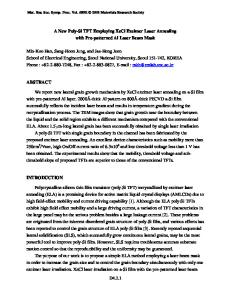Enhancement of Crystallinity with Fluorinated Amorphous Silicon (a-Si:H;F) Film by XeCl Excimer Laser Annealing
- PDF / 850,714 Bytes
- 5 Pages / 414.72 x 648 pts Page_size
- 45 Downloads / 444 Views
RESULTS AND DISCUSSION Figure 1 shows the temperature dependency on dark conductivity for both films (a-Si:H;F, a-Si:H) before laser annealing treatment. The darkconductivity of a-Si:H;F film was measured lager value of 1.5x10-5 Q'cm-1 than 3x10-9 Q'cm-' of a-Si:H at 20 'C. It may be considered that a little portion of micro-crystallinity was built up in a-Si:H;F film, which resulted from the decrease of deposition rate caused by the etching effects of fluorine atoms [7], but it was undetectable level by Raman spectroscopy. The activation energy of a-Si:H;F films reduced tc 0.3 from 0.53 of a-Si:H film's, which explains that defect states such as dangling bonds and SiH weak bonds were reduced in a-Si:H;F films, which provide thermal activation sites. The ratio of photoconductivity to darkconductivity in a-Si:H;F, had a small ratio of 1.5, while 63.6 in aSi:H, which also confirms that metastable states, which are responsible for the Staebler-Wronski effects, were reduced by passivation of dangling bonds or elimination of unstable hydrogen
bonds 10-2
20 W, 350 0 C
Zl0-3 -
• SiF4 =IH 2. 0 sccm
SIH4
10-4
10"6
SiF 4 = 2
10 sccm
Fig. i. Characteristics of darkconductivity
activation enery.: 0.3 eV
vs. temperature for a-Si:H (0)
(1-7
,
.0-9
2.6
2.8
3.0
S""" a-Si:H;F(A)
films which were deposited at the rf power of 20 W and substrate temperature of 350
0.53 3.2
and
3.4
3.6
0C.
1000/Temp. [1000/1K] Figure 2 shows Raman spectroscopy data of a-Si:H;F and a-Si:H films annealed at 300 mJ/cm 2 . Raman intensity of both films has broad spectrum around 500 cm-1 in contrast to that of single crystal, which is probably caused by the distribution of crystalline size provided that the crystalline modes arising from the crystallinity of various size are superimposed as a Gaussian peak. Therefore, it is considered that the mixed phase from amorphous silicon to microcrystalline exists in our laser annealed films. For the evaluation of crystallinity, we have used the integrated intensities of resolved mode corresponding to the crystalline (500, 520 nm) and
amorphous (480 nm) mode.[8] The characteristics of crystallinity with laser energy density was shown in figure 3. The crystallinity of a-Si:H;F film shows higher value than that of a-Si:H film
with laser energy density, which explain that the crystallinity is enhanced by involving fluorine atoms. We have also measured the characteristics of transient reflectance to analyze the laserinduced melt-recrystallization phenomena, and which was shown in Fig 4. The reflectance voltage in a-Si:H film before zero second, which is related to surface roughness of initial state, was measured lower value than that of a-Si:H;F film. It may be considered that the surface
100
roughness of both films were increased by plasma damage for a relatively high rf power of 20 W, while that of a-Si:H;F film was mitigated by fluorine atoms. The surface roughness of aSi:H;F and a-Si:H film were showed 20 A and 100 A, respectively with AFM. 9000
80
SSIH
4
SiF 4 = 2
20 sccm
SIH4,SiF
Data Loading...



